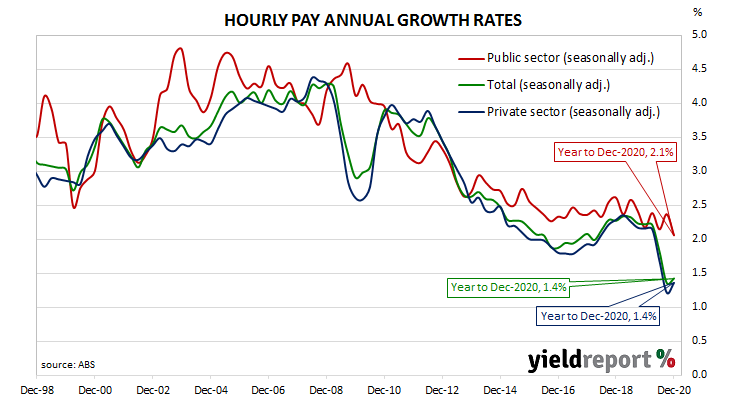Summary: December quarter wage growth jumps; annual growth rate closer to 1% than 2%; short-term factors in play, probably not sustainable; private sector wages increase by 1.4% over year, public sector up by 2.1%; “some upward pressure” expected in March quarter; lower ABS underutilisation rate implies higher wage growth in 2021.
After unemployment increased and wage growth slowed during the GFC, a resources investment boom prompted a temporary recovery back to nearly 4% per annum. However, from mid-2013 through to the September quarter of 2016, the pace of wage increases slowed, until mid-2017 when it began to slowly creep upwards. After remaining fairly stable at around 2.2% per annum from September 2018 to March 2020, the growth rate slowed significantly in the June and September quarters.
According to the latest wage price index (WPI) figures published by the Australian Bureau of Statistics (ABS), hourly wages grew by 0.6% in the December quarter. The increase was double the 0.3% rise which had been generally expected and markedly higher than the 0.1% growth rate which had been recorded in the September quarter. However, the year-on-year growth rate remained unchanged from the September quarter’s rate of 1.4%.
Westpac economist Lochlan Halloway said “the outcome is largely a function of short-term factors in the private sector, including the relaxation of wage freezes and the reversal of wage cuts introduced earlier in the year.” He doubted the December quarter’s rise as “sustainable”.

Long-term Commonwealth Government bond yields rose more than their US counterpart had overnight, ignoring US Fed statements “that there is still a long way to go”. By the end of the day, the 3-year ACGB yield had ticked up 1bp to 0.26%, the 10-year had gained 4bps to 1.61% while the 20-year yield finished 7bps higher at 2.31%.
In the cash futures market, expectations of a change in the actual cash rate, currently at 0.03%, remained fairly stable. At the end of the day, contract prices implied the cash rate would creep up from the current rate of 0.03% to 0.10% by mid-2022.
Hourly wage growth in the public sector has been generally faster than in the private sector since late 2013. There have been just a few quarters over this time period in which the difference has been in favour of the private sector but, unlike the previous three quarters, the December quarter was one of them. Wages in the private sector grew by 0.7% while wages in the public sector grew by 0.3%. Over the past 12 months, wages in the private sector increased by 1.4% while public sector wages grew by 2.1%. Annual wage growth in the two sectors had been at 1.2% and 2.4% respectively in the September quarter.

